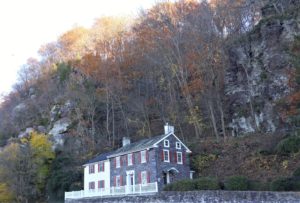Bucks history could be a “Jeopardy!” game.
Today I’m imagining myself as host Carlo, in the Alex Trebek memorial game of “Bucks County Jeopardy!” The category is “town names”.
Here’s the first challenge:
“This town used to be called Lingohocken.”
What’s the question?
Tick tock. If you’re local history expert Fletcher Walls in Doylestown or Clarence King in Northampton, you’d dive into the memory banks searching for “Lingohocken”. That’s “pleasant valley” in Lenni Lenape lingo, describing a fertile valley near Neshaminy Creek in Wrightstown.

Euro settlers loved the name. All was going well as the Reading Railroad laid down a carpet of steel through the valley from the main line in Warminster to New Hope in 1891. Victorian houses and some businesses sprang up around the Lingohocken depot, defining where rock quarries and agriculture were money makers. A complication arose when a new post office opened. There was another town in Pennsylvania with a similar name – “Wingohocken” in north Philadelphia. To avoid confusion, the feds asked folks in Lingohocken to come up with a new name. Drat! So they did.
The Jeopardy question: “What is Wycombe?”
Second answer on the big board: “This town was once called Buckingham.”
Hummm. Carlo is certain local college professor Bill Pezza knows the question. Seems like it should be Germantown or Chester to Carlo. William Penn’s charter from King Charles II directed him in his new colony “to erect and incorporate Towns into Boroughs, and Boroughs into Cities, and to constitute faires and markets therein, with all other convenient privileges and munities.” On Penn’s arrival in 1682, settlers had already gone about setting up boroughs. Chester took shape in that year. Germantown the following year. But the oldest? It was a town in Bucks – Buckingham – founded in 1681, a year before Penn stepped off the boat. It wasn’t incorporated as a borough until 1720. That still ranks it first ahead of Chester (1799) and Germantown (1854).
Correct Jeopardy question: “What is Bristol?”

Third “Jeopardy” answer: “This town once was Schencks Station.”
This is a toughy. Local historian Sally Sondesky probably would nail it. The original name comes from Dr. Joseph H. Schenck who built his “Evergreens” mansion on a beautiful 750-acre estate on the east bank of Neshaminy Creek. When the New York branch of the Reading Railroad established a train station near the doc’s manse, it named it “Schencks Station.” Soon, businesses and new homes sprouted about the depot. The station eventually closed, replaced by another nearby. Since Doc Schenck no longer identified what was going on locally, citizens offered a new name for the Bristol Township hamlet drawn from a town in the Surrey district south of London.
Correct Jeopardy question: “What is Croydon?”
Fourth Jeopardy answer: “This village began as Finney’s Mill.”
We’re now in Clarence King’s bailiwick. His ancestor was a grist miller on Bridgetown Pike in Northampton. So he certainly knows where Finneys Mill was on Mill Creek off the main road between Feasterville and Newtown (Route 532). The Finney family for years ground crops for flour and livestock feed. As the mill’s fortunes faded however, the hamlet took a new name – “Rocksville”. Seemed descriptive. Mill Creek was unusual for its swift current and extraordinarily rocky banks. As late as 1940, the state highway department referred to Rocksville on official maps. Seventy years earlier, however, a post office nearby chose a name honoring a European country that pioneer settlers came from. It took awhile before citizens in Rocksville decided their town name was hardly flattering and changed it to that of the post office.
Correct Jeopardy question: “What is Holland?”

Our last Jeopardy answer: “This township was first called ‘the place with three huts.’ ”
You have to reach way back into Upper Bucks history for the question that local historian Stephen Willey would know. The township before it became a township was favored by Native Americans, home to the great Shawnee Indian Chief Kakowwatchy and the Lenape medicine man Nutimus. European immigrants in 1735 took over after the tribes moved west. The Euros discovered so many bones of dead Indians scattered across ancient battlefields they built Indian skull pyramids as cornerstones to land purchases.
The settlers were quite industrious. Their pioneering manufacture of red tulip pottery and quality charcoal brought high praise. The township also was first in Bucks to join the state’s “good roads” movement. Hard-surfaced highways became the envy of other towns. All the while locals respected their Indian heritage. The Indian name for the area translated as “the place with three huts.” But choosing “Three Huts” as a township name didn’t make sense. So folks retained the Indian name. In all of Bucks this municipality is one of only two that have a Native American name. The other is Tinicum Township.
Correct Jeopardy question: “What is Nockamixon Township?”
***
Sources include “Place Names in Bucks County” by George MacReynolds published in 1942, and “Historic Wycombe: A Late-Victorian Village” by Mary Ann Sircely published in 1989. Appreciation to Bill Pezza of Bristol, Sally Sondesky of Bensalem, Stephen Willey of Durham plus Clarence King and Fletcher Walls for their help over the years in leading me through Bucks County history.

